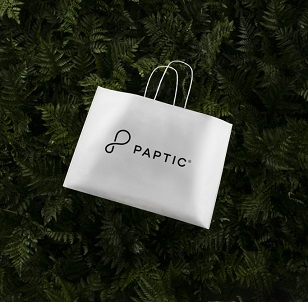At the Bio-Based Materials conference in Cologne, organised by nova-Institute, a special material came in second at the election of the bio-based material of the year: Paptic®. ‘The next generation of paper bags – lighter and stronger’, as they advertise themselves. Paptic has a very agreeable feel: soft, strong and foamy, without the coarseness of paper or the cold smoothness of plastic. But what is it made of?
 Paptic, an innovative product
Paptic, an innovative product
Paptic is a Finnish product mainly on the basis of wood fibre, that seeks its strength in three areas: the EU directive that seeks to reduce plastic bag use by 55% in 2019; its largely biobased and biodegradable constitution, and its usability on all existing machinery, in particular for printing and recycling. The producers target the carrier bag market as the material’s first application. The advantage over paper is not just that it feels smoother, but also that it saves 50% of the weight and 30% of energy input. On its website the company summarises Paptic benefits when compared with its main competitors:
• Paper is inefficient and not suited for multiuse due to weight and poor pocketability
• Biodegradable plastics break easily when loaded and are not recyclable
• Biobased plastics are not the answer to ocean pollution as they are non-degradable and expensive
Summing up: Paptic is recyclable, lightweight, durable & soft, 80% renewable. And the website mentions the first major client: the Body Shop.
This sounds very attractive. But apart from price, many other aspects of the material remain rather mysterious. Now contestants on the Bio-Based Materials contest always have their secrets. Contestants are new entrants on the market. They may not have their patents right already, or they may not have any patents pending at all. They have to shield the production details of the material by a certain level of secrecy. But in the case of Paptic, this mysteriousness somewhat clouds the judgement. Certainly in view of the suggested magnitude of the market for the material.
Maybe something very big indeed
We tried to find some clearer answers from the company. First the nature of the material. ‘Paptic is a novel wood fibre based material, where the whole fibre matrix is novel. This is due to the new innovative technology the material production is based on.’ Then: biodegradability. ‘80% of Paptic are biobased and biodegradable fibres, where the main ingredient is wood fibre. The rest (20%) are non-biodegradable ingredients that are typical to conventional paper making. Our aim is, however, to produce a 100% biodegradable product in the future, which would mean that the entire product would biodegrade if ended up in nature.’ Let’s say, if the main Paptic ingredient is wood fibre, we might call it a novel kind of paper, but with that special feel and strength. Which also explains its easy recyclability. Elsewhere on the website, the company says: Paptic® will be recycled with cardboard.
We happily leave the final judgment to the reader. Paptic might become very big indeed.
Interesting? Also read our columns:
Fibres of the future: cellulosic fibres from wood
CocoPallet: grow in niches and compete on price
Bio-Lutions wins Bio-Based Material of the Year 2017 Innovation Award
